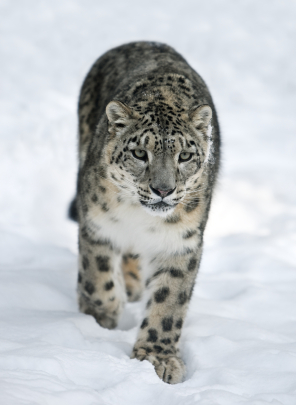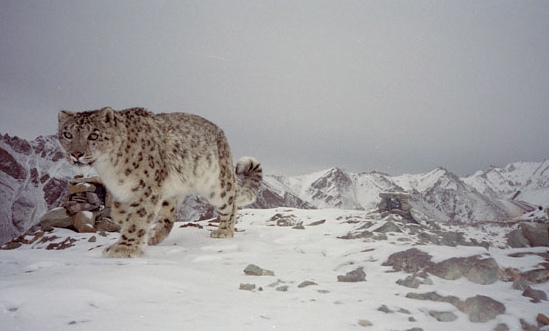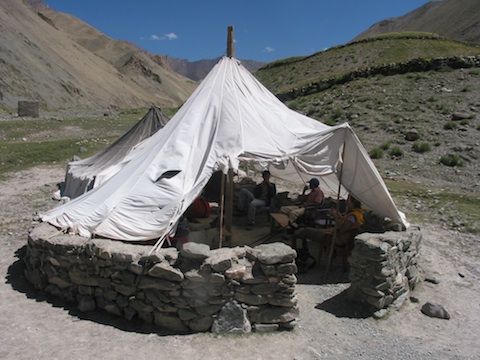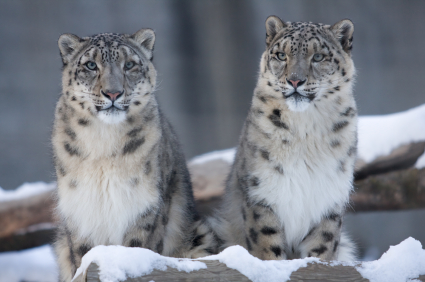
|
|
 |
||||||||||||||||||||
|
|
|||||||||||||||||||||
|
THE SNOW LEOPARD CONSERVANCY Working to Save Endangered Cats Through Conservation and Management By Katey Pfeil  High in the arid mountains of Central Asia lies an area that is among some of the most unproductive range land in the world; however, this unforgiving landscape does provide a home to the magnificent snow leopard. Because this elusive cat lives in rugged terrain dotted with cliffs and narrow crevices, it is rarely seen - adding to the mystery surrounding it. Just over ten years ago, snow leopard populations in certain areas were double what they are today, but in regions such as those in Mongolia, the leopards have disappeared entirely. High in the arid mountains of Central Asia lies an area that is among some of the most unproductive range land in the world; however, this unforgiving landscape does provide a home to the magnificent snow leopard. Because this elusive cat lives in rugged terrain dotted with cliffs and narrow crevices, it is rarely seen - adding to the mystery surrounding it. Just over ten years ago, snow leopard populations in certain areas were double what they are today, but in regions such as those in Mongolia, the leopards have disappeared entirely.It’s estimated there are between 3,500 and 7,000 snow leopards in the wild and about 700 located in zoos worldwide. Threats to snow leopards include loss of habitat, poaching and other human-animal conflicts. Yet despite these depressing numbers, there seems to be a ray of hope: Since 2000, an organization known as the Snow Leopard Conservancy (SLC) has been making it their mission to restore snow leopard populations while simultaneously helping the humans who share the land with them. By helping to stimulate the local economy through various community-based projects, as well as aiding farmers in building predator-proof livestock pens, human-leopard conflicts have subsided, and tolerance and appreciation for the endangered animal has increased. The SLC was started by Rodney Jackson, the only conservationist to have devoted his entire career to saving the snow leopard, and widely recognized as an expert in snow leopard studies. Jackson’s fascination with the leopards began in the 1970’s  when he was captivated by the world’s first photograph of a snow leopard in National Geographic. As Jackson gained experience as an animal conservationist and explorer, he was motivated to create his own radio-tracking study. When he won the prestigious Rolex Award for Enterprise in 1981, he was finally able to do so. Soon after, he founded the SLC. when he was captivated by the world’s first photograph of a snow leopard in National Geographic. As Jackson gained experience as an animal conservationist and explorer, he was motivated to create his own radio-tracking study. When he won the prestigious Rolex Award for Enterprise in 1981, he was finally able to do so. Soon after, he founded the SLC. The organization’s mission centers on a unique system in which leopard populations are guarded by local citizens who agree to live at peace with the cats in exchange for reaping benefits that SLC programs bring to their communities. “Ultimately, our main goal is to work ourselves out of a job,” says Darla Hillard, Program Coordinator for the SLC. “We want local people to get to the point where they can take care of both themselves - and the leopards - without us.” Over the last 28 years, the SLC has developed into an organization that helps local villagers who live in snow leopard territory improve their standard of living. This is made possible through the various programs the conservancy has established that encourage economic stability for impoverished locals who, without such resources, would not have the “luxury” to help alleviate the snow leopard’s plight. One such  program coordinates tours for travelers looking to gain an insight into the culture of the indigenous people. program coordinates tours for travelers looking to gain an insight into the culture of the indigenous people. These community-based programs work by focusing on the immediate socio-economic problems locals face such as poverty, hunger, and the care of precious livestock. Because many of the mountain people who share the landscape with the snow cat live on less than $1 (US) dollar a day, conservation programs are aimed at increasing their standard of living and by helping them with such pertinent issues as veterinary care or the creation of predator-proof corrals. The livestock insurance plan is another program that's been designed to reduce the number of human-snow leopard conflicts. When local villagers are compensated monetarily for killed livestock due to leopard attacks, they're less likely to harm the cats or poaching them in order to make ends meet. As one villager noted, “We are very happy, for the sake of our livestock, and for the snow leopards...because now, we no longer have to lie awake on the cold ground next to the pen (to protect the livestock).”  The SLC relies on donations, grants and fund-raising to continue thriving, with a substantial donation arriving via their collaboration with KarmaQuest, the group that coordinates the homestay programs. For more information on the Snow Leopard Conservancy, or to inquire about donation opportunities, visit www.snowleopardconservancy.org. For information on home-stay programs coordinated through the conservancy, go to: EcoExperiences Photo credits: iStockphoto.com; Snow Leopard Conservancy; Wendy Lama (KarmaQuest) |
|
|
|
|
| Site Map |